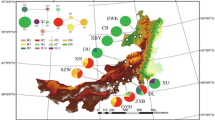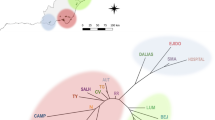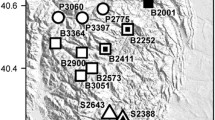Abstract
We quantified genetic diversity and gene flow among eight populations of Reaumuria soongorica in Inner Mongolia, China. Our results showed that genetic differentiation of R. soongorica across the Inner Mongolian plateau is primarily clinal in nature and is driven primarily by differential landscape resistance across areas with changing patterns of seasonal precipitation, perhaps as a result of differential timing of reproductive phenology along precipitation gradients. Finding that seasonal patterns of precipitation, and not temperature, drive population connectivity and gene flow may have important implications for predicting the effects of climate change on this keystone foundation species and devising effective strategies to utilize it in restoration efforts to ameliorate ongoing desertification in the region. Genetic diversity was highest in the western part of the sampled population, perhaps indicating that this region has historically harbored the highest effective population size of the species or may have served as the source of recent range expansion to other parts of the sampled range which exhibited lower genetic diversity. Understanding the ecological drivers of these relationships might be critical to resolving the causes of the geographical pattern of diversity, and could be important in understanding the ecology of the species sufficiently to anticipate climate change effects and effectively implement management strategies to restore the species and combat desertification.




Similar content being viewed by others
References
Amos J, Bennet AF, Mac-Nally R, Newell G, Radford JQ, Pavlova A, Thompson J, White M, Sunnucks P (2012) Predicting landscape genetic consequences of habitat loss, fragmentation and mobility for species of woodland birds. PLoS One 7:e30888
Bai J, Ge QS, Dai JH, Wang Y (2010) Relationship between woody plants phenology and climate factors in Xi’an, China. Chin J Plant Ecol 34(11):1274–1282
Beebee T, Rowe G (2003) An introduction to molecular ecology. Oxford University Press, New York
Chai XY, Chen SL, Xu W (2010) Using inter-simple sequence repeat markers to analyze the genetic structure of natural Pteroceltis tatarinowii populations and implications for species conservation. Plant Syst Evol 285:65–73
Coyne JA, Orr AH (2004) Speciation. Sinauer Associates, Sunderland
Cui DF (1988) A primary study on the classification, distribution, ecological characteristics, morphological characteristics and anatomical characteristics of genus Reaumuria in China. Arid Zone Res 1:65–69
Cushman SA (2015) Pushing the envelope in genetic analysis of species invasion. Mol Ecol 24:259–262
Cushman SA, Landguth EL (2010) Spurious correlations and inference in landscape genetics. Mol Ecol 19:3592–3602
Cushman SA, McKelvey KS, Hayden J, Schwartz MK (2006) Gene-flow in complex landscapes: testing multiple models with causal modeling. Am Nat 168:486–499
Cushman SA, Wasserman TN, Landguth E, Shirk AJ (2013) Re-evaluating causal modeling with Mantel tests in landscape genetics. Diverstiy 5:51–72. doi:10.3390/d50x000x
Cushman SA, Max T, Meneses N, Evans LM, Ferrier S, Honchak B, Whitham TG, Allan GJ (2014) Landscape genetic connectivity in a riparian foundation tree is jointly driven by climatic gradients and river networks. Ecol Appl 24:1000–1014. doi:10.1890/13-1612.1
de León LF, Bermingham E, Podos J, Hendry AP (2010) Divergence with gene flow as facilitated by ecological differences: within-island variation in Darwin’s finches. Philos Trans R Soc B 365:1041–1052
Doyle J (1999) DNA protocols for plants—CTAB total DNA isolation. In: Hewitt GM, Johnston A (eds) Molecular techniques in taxonomy. Springer, Berlin, pp 283–293
Dyer RJ, Nason JD, Garrick RC (2010) Landscape modeling of gene flow: improved power using conditional genetic distance derived from topology of population networks. Mol Ecol 19:3746–3759
Editorial Committee of Flora Reipublicae Popular Sinicae, Chinese Academy of Science (1990) Flora of China (50 vol part 2). Science Press, Beijing
Evanno G, Regnaut S, Goudet J (2005) Detecting the number of clusters of individuals using the software structure: a simulation study. Mol Ecol 14:2611–2620
Excoffer L, Smouse PE, Quatrio JM (1992) Analysis of molecular variance inferred from metric distances among DNA haplotypes: application to human mitochondrial DNA restriction data [J]. Genetics 131:479–2491
Falush D, Stephens M, Pritchard JK (2003) Inference of population structure using multilocus genotype data: linked loci and correlated allele frequencies. Genetics 164:1567–1587
Gavrilets S (2000) Waiting time to parapatric speciation. Proc R Soc B 570(267):2483–2492
Gavrilets S, Vose A (2007) Case studies and mathematical models of ecological speciation. 2. Palms on an oceanic island. Mol Ecol 16:2910–2921
Guo ZX, Zhang XN, Wang ZM et al (2012) Responses of vegetation phenology in Northeast China to climate change. Chin J Ecol 29(3):578–585
Gupta M, Chyi YS, Romero-Severson J, Owen JL (1994) Amplification of DNA markers from evolutionarily diverse genomes using single primers of simple-sequence repeats. Theor Appl Genet 89:998–1006
Hijmans RJ, Cameron SE, Parra JL, Jones PG, Jarvis A (2005) Very high-resolution interpolated climate surfaces for global land areas. Int J Climatol 25:1965–1978
Hou XY (1983) Vegetation of China with reference to its geographical distribution. Ann Mo Bot Gard 70:509–549
Inner Mongolia and Ningxia Comprehensive expedition of Chinese academy of sciences (1985) Vegetation of Inner Mongolia. Science Press, Beijing
Iverson LR, Prasad AM (2002) Potential redistribution of tree species habitat under five climate change scenarios in the eastern US. For Ecol Manag 155:205–222
Jiang HQ (2004) Plants ecology. Higher Education Press, Beijing
Legendre P, Fortin MJ (2010) Comparison of the Mantel test and alternative approaches for detecting complex multivariate relationships in the spatial analysis of genetic data. Mol Ecol 10:831–844
Li B (1990) Natural resources and environment research in Ordos Plateau, Inner Mongolia. Science Press, Beijing
Li JP, Yang XG, Fu H, Zhang BL (2005a) The content and distribution characteristics of some osmotic adjusting materials in three species of desert plants in Alashan desert of northwest China. Pratacult Sci 22(9):35–38
Li X, Wang YC, Zheng R (2005b) Water parameters of xeric shrubs in west Erdos region (I). J Desert Res 25(4):581–586
Li XL, Chen J, Wang G (2008) Spatial autocorrelation analysis of ISSR genetic variation of Reaumuria soongorica population in northwest of China. J Desert Res 28(3):469–472
Li Z, Chen J, Zhao G-F, Guo Y-P, Kou Y-X, Ma Y-Z, Wang G, Ma X-F (2012) Response of a desert shrub to past geological and climatic change: a phylogeographic study of Reamuria soongorica (Tabmaricaceae) in western China. J Syst Evol 50:351–361
Liu JQ, Qiu MX, Pu JC, Lu ZM (1982) The typical extreme xerophyte —Reaumuria soongorica in the desert of China. Acta Bot Sin 24(5):485–488
Ma YQ (1989) Flora of Inner Mongolia, vol 3, 2nd edn. The Peoples Press of Inner Mongolia, Hohhot
Ma MH, Kong LS (1998) The bio-ecological characteristics of Reaumuria soongorica on the border of oasis at Hutubi, Xinjiang. Acta Phytoecol Sin 22(3):237–244
Mantel N (1967) The detection of disease clustering and a generalized regression approach. Cancer Res 27:209–220
McKinnon JS, Mori S, Blackman BK, David L, Kingsley DM et al (2004) Evidence for ecology’s role in speciation. Nature 429:294–298
Meirmans PG (2012) The trouble with isolation by distance. Mol Ecol 21:2839–2846
Nei M (1972) Genetic distance between populations. Am Nat 106:282–292
Nei M (1973) Analysis of gene diversity in subdivided populations. Proc Natl Acad Sci USA 70:3321–3323
Niemiller ML, Fitzpatrick BM, Miller BT (2008) Recent divergence-with-gene-flow in Tenessee cave salamanders (Plethodontidae; Gyrinophylus) inferred from gene genealogies. Mol Ecol 17:2258–2275
Nix H (1986) A biogeographic analysis of Australian elapid snakes. In: Atlas of elapid snakes of Australia. Australian Government Publishing Service, Canberra
Nosil P (2008) Speciation with gene flow could be common. Mol Ecol 17:2103–2106
Pritchard JK, Stephens P, Donnelly P (2000) Inference of population structure using multilocus genotype data. Genetics 155:945–959
Qian W, Ge S, Hong DY (2001) Genetic variation within and among populations of a wild rice Oryza granulate from China detected by RAPD and ISSR markers. Theor Appl Genet 102:440–449
Qian Z-Q, Xu L, Wang Y-L, Yang J, Zhao G-F (2008) Ecological genetics of Reamuria soongorica (Pall.) Maxim. population in the oasis-desert ecotone in Fukang, Xinjiang, and its implications for molecular evolution. Biochem Syst Ecol 36:593–601
Rehfeldt GE, Crookston NL, Warwell MV, Evans JS (2006) Empirical analyses of plant-climate relationships for the western United States. Int J Plant Sci 167(6):1123–1150
Schwartz MK, McKelvey KS (2009) Why sampling scheme matters: the effect of sampling scheme on landscape genetic results. Conserv Genet 10(2):441–452
Smouse PE, Long JC, Sokal RR (1986) Multiple regression and correlation extensions of the Mantel test of matrix correspondence. Syst Zool 35:627–632
Song WM, Zhou HY, Jia RL, Zhao X, Feng L, Tan HJ (2008) Response of photosynthesis function and trehalose content of four desert plants to gradual drought stress. J Desert Res 28:449–454 (in Chinese)
Song CQ, You SC, Ke LH, Liu GH, Zhong XK (2012a) Phenological variation of typical vegetation types in northern Tibet and its response to climate changes. Acta Ecol Sin 32(4):1045–1055
Song XM, Yang JY, Lv MT, Yang M, Zhang ZR (2012b) Responses of Reaumuria soongorica seed germination to salt stress and moderate drought. J Desert Res 32(6):1674–1680
Wang YR, Zeng YJ, Fu H, Chen SK (2002a) Affects of over grazing and enclosure on desert vegetation succession of Reaumuria soongrica. J Desert Res 22(4):321–327
Wang YR, Zeng YJ, Zhang BL, Ta LT (2002b) Water distribution patterns in different degraded desert grasslands of Reaumurta soongorica. Chin J Appl Ecol 13(8):962–966
Wasserman TN, Cushman SA, Schwartz MK, Wallin DO (2010) Spatial scaling and multi-model inference in landscape genetics: Martes americana in northern Idaho. Landsc Ecol 25:1601–1612
Weising K, Atkinson RG, Gardner RC (1995) Genomic fingerprinting by microsatellite-primed PCR: a critical evaluation. PCR Methods Appl 4:249–255
Wright S (1931) Statistical methods in biology. J Am Stat Assoc 26(173):155–163
Wu ZY (1980) Vegetation of China. Science Press, Beijing
Xiao SC, Xiao HL, Song YX, Duan ZH, Lu MF (2006) Dendrochronology study on response of Reaumurta soongorica to water-heat variation. J Desert Res 26(4):548–552
Yang JY, Cushman SA, Yang J, Yang MB, Bao TJ (2013) Effects of climatic gradients on genetic diversification of Caragana on the Ordos plateau, China. Landsc Ecol 28(9):1729–1741
Yeh FC, Yang RC, Boyle T (1999) POPGENE. Microsoft window-based freeware for population genetic analysis. Release 1.31. University of Alberta, Edmonton
Yong SP (1990) Study on the basic characteristics of desert flora. J Inn Mongolia Univ 21(2):241–247
Zeng YJ, Wang YR, Zhuang GH, Yang ZS (2004) Seed germination responses of Reaumuria soongorica and Zygophyllum xanthoxylum to drought stress and sowing depth. Acta Ecol Sin 24(8):1630–1634
Zhang DY (2005) Discuss on some systematical problems of Tamaricaceae. Acta Bot Yunnanica 27(5):471–478
Zhang YJ, Gao RX, Li QF (2008) Analysis on the population genetic diversity of desert shrub Reaumuria soongorica in disturbed habitats. J Arid Land Resour Environ 22(3):147–151
Zietkiewicz E, Rafalski A, Labuda D (1994) Genome fingerprinting by simple sequence repeat (SSR)-anchored polymerase chain reaction amplification. Genomics 20:176–183
Acknowledgments
This work was supported by The State Key Basic Research Development Programme of China (Grant No. 2012CB722201),science and technology research projects of Inner Mongolia Education Department of China (NJ10002), The Natural Science Foundation of Inner Mongolia Autonomous Region of China (2014MS0350), and US Forest Service Rocky Mountain Research Station.
Author information
Authors and Affiliations
Corresponding author
Additional information
Communicated by Siegy Krauss.
Electronic supplementary material
Below is the link to the electronic supplementary material.
Rights and permissions
About this article
Cite this article
Yang, J., Cushman, S.A., Song, X. et al. Genetic diversity and drivers of genetic differentiation of Reaumuria soongorica of the Inner Mongolia plateau in China. Plant Ecol 216, 925–937 (2015). https://doi.org/10.1007/s11258-015-0479-3
Received:
Accepted:
Published:
Issue Date:
DOI: https://doi.org/10.1007/s11258-015-0479-3




